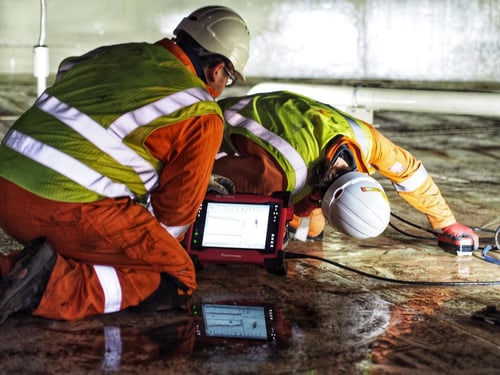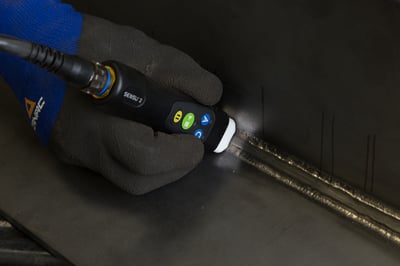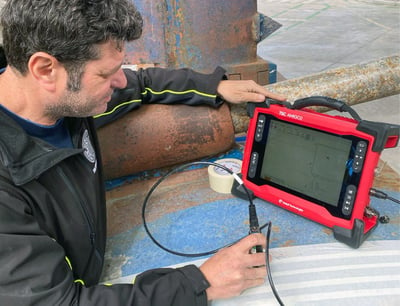Any industrial manufacturer can relate to the financial pressure to minimize downtime for maximum productivity, and process plants are no exception. The inspection and maintenance programs for these factories are extensive given the number of different components and assets hard at work. Operators are moving towards risk-based inspection, or RBI, to reduce shutdowns and best leverage available resources during planned outages. Using the right non-destructive testing method can make all the difference in increased productivity, and this article shares why Alternating Current Field Measurement, or ACFM®, is the answer to more efficient process plant inspection applications.
Given their working environment, pressure vessels, pipework, towers, tanks, and various infrastructure found in oil, gas, chemical, and petrochemical plants are typically covered in paint, epoxy, or oxide layers for corrosion resistance. Conventional inspection techniques require that this coating be removed in order to detect corrosion or cracking. For wet fluorescent magnetic particle testing (WFMT), sandblasting is employed which results in potential environmental waste. Naturally, the protective layers must be reapplied after inspection, and this can be problematic for assets —particularly pipework— operating at high or low temperatures. So, not only do archaic techniques like WFMT increase inspection time, require cleanup, and expose vulnerable metalwork, it often requires a plant shutdown (you know, that thing we’re trying to avoid).

On the other hand, ACFM requires minimal surface preparation, i.e., the protective layers found on support vessels, piping, and the like remain intact. The electromagnetic testing technique, not requiring consumables, detects surface-breaking cracks in metal through coatings. It can be used as a screening tool ahead of major surface cleaning to avoid preparing assets with no cracking. ACFM offers depth sizing to establish thresholds for trivial cracking and prevent any unnecessary grinding. In general, ACFM has proven to be 60% faster than WFMT.
From a time and cost savings point of view, a paper1 shared these impressive results:
- For a 6x6ft (1.8x1.8m) vessel, ACFM saved 62% on cost and 63% on time.
- For a 10x50ft (3x15m) vessel, ACFM saved 65% on cost and 58% on time.
- For a 20x85ft (6x26m) tower, ACFM saved 61% on cost and 57% on time.
- 58 vessels were inspected over two weeks using 2 ACFM operators instead of 6 magnetic particle inspection (MPI) inspectors for a cost savings of $500,000.
- A 600ft (152m) weld on a painted structure was inspected in 1.5 days with ACFM instead of 6 days with MPI.
When the Brazilian State Oil Company PETROBRAS extended their ACFM use from offshore platform inspections to the assessment of gas storage spheres, also known as Horton spheres, they found twice as many crack indications as MPI and the inspection was three times faster than MPI – even faster when report writing was taken into account2. And this was just the results with legacy ACFM technology. Today, even quicker inspections with higher quality data collection are possible with leading edge equipment from Eddyfi Technologies.

Moreover, ACFM enables in-service assessments with its tolerance to high and low temperatures ranging from 500° C (932° F) to -20° C (-4° F). That’s right: no shutdown needed. With an air-cooled probe for the high temperatures encountered in a range of process plant equipment, ACFM enables a robust maintenance strategy with live monitoring and emergency response actions. Take re-certification of a gas process plant for example. With ACFM able to perform high temperature inspection and monitoring of cracks, the efficiency gains are palpable.

Alternating Current Field Measurement technology has other notable unique features. ACFM pencil probes offer better tolerance to probe handling and gloved probe tolerance in those extreme temperature settings. ACFM pencils can be used in lieu of multiple expensive arrays where weld geometries are diverse. Their 15mm (0.6in) wide scan path makes flaw detection possible, even without scanning directly on top of the defect; this is ideal for the intricate spaces encountered in complex process plant equipment. Again, this is a great benefit to operators who want to spend the least amount of time in those hot and low temperature process plant environments. Compliant array probes can be used on any compatible parts to further maximize productivity.
When met with confined spaces, heights, and other inhospitable environments, robotically deploying ACFM probes is a proven alternative. The latest SENSU® 2 compliant array probe is crawler ready with a 90mm (3.5in) wide coverage, spring loaded sensors with 12mm (0.5in) of travel, and scan speeds of 50mm (2in) per second for clean data acquisition despite remote operation. Learn more about the solution that eliminates the need for working at heights, scaffolding, or specialized staff with robotics for NDT data collection in our eBook.

The TSC Amigo™ 2 is the only data acquisition instrument offering true ACFM. Over its 30-year history, the technology has been recognized by industry leaders for its ruggedness, reliability, and ease of use. Count on the Amigo 2 to detect and measure transverse cracks in pressure vessel plates, cracking in coke drums as a result of thermal and mechanical fatigue, defects in reactor catalyst bed support and nozzles, or cracking in the longitudinal welds common in double-walled carbon steel vessels. Identify cracking in distillation or absorber towers. Uncover stress corrosion cracking under insulation. Locate external stress corrosion cracking, or SCC, in transmission pipelines and process pipework. Eddyfi Technologies offers the leading edge ACFM technology that avoids coating removal, process plant shutdown, and ultimately the maximum productivity that all operators are after.

To learn more about Alternating Current Field Measurement with real-world examples, download this eBook, and contact us to discuss your specific inspection requirements.
1 Cost Benefit Applications Using the Alternating Current Field Measurement Inspection Technique. A Raine. TSC Inspection Systems.
2 Experiences in The Use of ACFM For Offshore Platform Inspection in Brazil. F Marques, M Martins, D Topp. PETROBRAS, TSC Inspection Systems. WCNDT Rome 2000.

